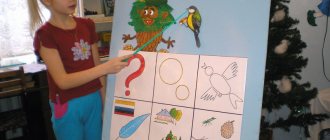Features of interaction between a teacher-psychologist and kindergarten teachers
11. Provides psychological preventive assistance to educators in order to prevent their emotional burnout.
12. Helps improve the level of communication between the teacher and parents.
It can be noted that in the joint work of a teacher-psychologist and a teacher, one of the necessary conditions is the creation of a positive emotional background and response of the child. On the basis of this, work on the development and sometimes correction of the emotional-volitional, cognitive and personal spheres of children occurs most effectively.
One of the forms of interaction between a teacher and specialists, in particular with an educational psychologist, is the “Notebook of interaction with specialists”. The interaction notebook includes a section “Recommendations of a teacher-psychologist” for working with children. The recommendations of the educational psychologist are entered into the notebook monthly. They prescribe games, exercises for reinforcing the information received with children during a lesson with a teacher-psychologist, as well as recommendations for individual work with a specific child.
Having carried out correctional work with children on the specified topic, the teacher makes notes in the “Notebook for interaction with specialists”, indicating the methods and methods of the work carried out. If the teacher experiences difficulties in selecting material, then the materials are selected and discussed with a teacher-psychologist.
In the “teacher-psychologist-educator” model of support, questions like: who needs whom more? Or who “supplies” information about the child to whom: the educator to the educational psychologist or the educational psychologist to the educator? The conclusion suggests itself: without mutual exchange of information, neither the educator nor the educational psychologist will be able to competently help a child experiencing certain difficulties to find optimal conditions for his learning and development.
On the one hand, an educational psychologist needs information from the teacher, the results of his observations and analysis of the characteristics of the preschooler’s activity and behavior. Without this data, it is difficult for him to correlate his psychological facts with the child’s real life activities and to decide on priority areas of work with him.
On the other hand, the educator needs information from a teacher-psychologist about the internal “picture” of observed external manifestations, about the deep sources of existing educational and socio-psychological problems. Without this information, it is difficult for the educator to build a competent program of his own pedagogical actions.
Meanwhile, educational practice shows that it is not always possible to organize the interaction of teachers and psychologists effectively.
MAGAZINE Preschooler.RF
Kaznacheeva Nina Ivanovna teacher-psychologist MDOU No. 76 p. Rechitsa Moscow region consultations, psychological assistance, promotion of psychological knowledge, trainings, KVN, seminars, presentations, lectures, poster information. A conversation with a teacher can be informational or diagnostic in nature. The psychologist conducts an informational conversation when hiring new teachers, or when he himself comes to the preschool team for the first time. It can reveal creative potential and the level of conflict. A diagnostic conversation allows you to identify a problem that worries the teacher and choose methods to solve it. Informational conversation. *What would you like to do if you weren't a teacher? *What advantages do you find in your work? *What “cons” do you find in your work? *What could you suggest to improve the psychological climate in the team? *How do you see parents helping you? *What information about the characteristics of children’s age, behavior, and abilities do you lack? *What could you teach your colleagues? *Are you a night owl or a morning person? *What activities do you enjoy teaching the most? *how do you prefer to relax? *What incentives should be introduced for educators? Diagnostic conversation. The problem is overwork *When did you notice excessive fatigue? *How does fatigue manifest itself? *How do you try to cope with fatigue? *How do you usually spend your evening or day off? *How do you see an ideal vacation? *At what time of day do you feel most tired? *Do you consider the responsibilities assigned to you excessive, the demands too high? *Who do you think could help you cope with fatigue? *Do you suffer from insomnia? *Do you take sedatives? *What do you think is the real reason for your overwork? A conversation allows you to get to know a person better, identify what worries him, and create a primary psychological basis for further diagnosis. The information obtained during the conversation can be supplemented with test results. If a new teacher comes to the team, a psychologist can diagnose him, process the results obtained, and present the results to the manager. Diagnostics can be aimed at determining personal qualities: goodwill, the ability to listen to other people, patience, endurance and self-control, independence and initiative, the desire to improve professionally, organization, the ability to work in a team, a sense of humor, creativity, literacy, erudition. To check how developed an employee’s imagination and creative potential are, you can invite him to transform into Cinderella, Karabas-Barabas, the Snow Queen, or come up with a design for a game room. Whether a person has literate and figurative speech can be determined by asking him to write an essay “One day in the life of a teacher.” The general erudition of an employee can be checked. Inviting him to answer questions from several areas of knowledge, write a short script for the interactive games “In the Land of Mathematics”, “Our Home is the Earth”. Consulting is a very responsible and difficult task. Caregivers are very sensitive to criticism and disapproval. Consultations may concern: • Personal problems; • Relations with colleagues; • Relationships with children; • Relationships with parents. The optimal procedure for conducting a consultation is as follows. 1. Relaxation (put yourself at ease) 2. Leading to the essence of the problem. 3. Discussion of the essence of the problem. 4. Discussion of ways to solve the problem. 5. Acceptance of ways to solve the problem. Emergency psychological assistance. This is a type of psychological assistance that a psychologist provides daily to preschool employees upon their request (stress, conflict, chronic fatigue syndrome). If a teacher turns to a psychologist while he is working with children, the children should be given independent tasks or left with an assistant teacher and go into the next room. Find out the reason for the request, suggest taking a few deep breaths and exhalations. Drink some water. Divide the children into groups and deal with the problem as quickly as possible. Why? *The condition and mood of the teacher affects the children. *Emotional state can have a significant impact on the physical state of the teacher. *If you try to put off solving a problem, this may be perceived as ignoring and unwillingness to help. The employee should be given the opportunity to express the essence of the problem and formulate an attitude towards it, without trying to analyze anything. When the person being counseled expresses everything, you should try to take the position of both himself and the person with whom the conflict occurred. Then propose a way to temporarily resolve the problem in order to subsequently analyze and solve it finally. Psychological safety Dear colleagues, it’s no secret that many of us have experienced “psychological pressure.” It’s good if this is a short-term fact. And if this happens for a long time and is harmful to health. What do you need to know to cope with the situation? First, I will introduce you to the terminology accepted in modern psychology. Mobbing is any pathological action at the place of work or in connection with work, psychological terrorism for more than six months. Mobber - leader or members of a team, provocateurs of psychological terror, initiator of terror. Mobbing is psychological violence over several weeks. Mobbing is determined by: * gestures * words * behavior or position Types of mobbing: * horizontal (colleague against colleague) * downward (subordinates against the manager) * upward (manager against the subordinate) * mixed (manager, subordinates). Victims of mobbing: *young professionals *35-46 years old *pre-retired *talented, competent *single mothers *widows *unmarried women 10 rules to resist mobbing: 1. be patient (the fight is tiring) 2. do not give in to despair, disappointment, do not take advantage blame yourself 3. don’t think about “sick leave”, the situation will only get worse 4. don’t think that you’re alone in such a situation 5. get ready to fight back, seek help from people not related to the mobber: doctor, lawyer, trade union committee 6. collect documents indicating mobbing, keep a health calendar 7. look for allies among your colleagues, it is important to inform your family about what is happening 8. contact the media 9. take advantage 10. act in accordance with the law If you see that a colleague is being mobbed, do not stand aside, extend your hand help. It is good to use articulation of the essence of the conflict. Advice: Teach yourself to be free from the opinions of others! Learn to respect yourself and others! Effective ways to prevent conflicts in teachers. team - creating a favorable atmosphere, increasing the psychological culture of the administration and teachers, mastering techniques for self-regulation of emotional states in communication. In order to prevent the occurrence of conflicts in pedagogical in a team, you can use the following diagnostic techniques: 1. Methodology for determining the group cohesion index of the team (Sishora). 2. Study of psyche. Climate (Lutoshkin map diagram). 3. Test “Study of the characteristics of response in a conflict situation” (K. Thomas). 4..Questionnaire “Relationships in pedagogy.” team." 5. Methodology for diagnosing interpersonal relationships by T. Leary 6. Diagnosis of workability and compatibility. 7. Methodology for determining the management style of a work team. 8.Diagnostics of the dominant psychological defense strategy. Development of team cohesion • joint events; • mobilizing the strength of team members to solve the problem; • delegation of powers; • training. Working with personal problems • referral to a specialist; • training sessions; • connection of the administration with permission. Recommendations for the manager to reduce conflict with subordinates: • show care towards them; • do not abuse official power; • effectively use the method of persuasion; • improve the style of your organization of work with subordinates; • inform all teachers when distributing bonuses and salary increases (social justice and transparency); • prevent and eliminate interpersonal conflicts. Active forms of work in pedagogy. conflict prevention team • “Pushing”. Two competitors must raise their arms above their heads, join hands with their fingers intertwined, and push each other in such a way as to force the opponent to touch the wall. • “Clap your hands.” Person A extends his hands, palms down. Person B palms up and places them under Person A's hands. Goal: B tries to slap A's palms by quickly moving his hands in the direction of A's palms as soon as B begins to move, A tries to move his hands away before B can slap them. • The person is asked to curl up into an “elastic ball”; someone from the group whom he chooses “turns around” him, he can resist, or he can succumb. Some group members try to help him maintain his position, others “turn him around.” • Role-playing and business games. • Group cohesion exercises. • Art therapeutic exercises. Relaxation exercises 1. Walk. Teachers sit with their eyes closed to music (wind music) for 10 minutes. The psychologist suggests imagining the most beautiful and favorite places you have visited. After listening, they exchange impressions 2. I’m lying in the sun. Teachers sit on chairs or rugs. Relax your arms and legs as much as possible. At the signal from the psychologist, “I’m lying in the sun,” they lean to the right; at the signal, “And I’m looking at the sun,” they lean to the left. (3 times) 3. The path to yourself. Close your eyes. Take 3 deep breaths in and out. Remember yourself at 10 years old. Remember any joyful event that happened to you at this age, remember every detail. (10 min). 4. Write with your chin. Close your eyes and write your name in the air with your chin. 5. Lazy ball. To the music of L. Beethoven's "Moonlight Sonata", teachers slowly throw the ball to each other. (3 min. 0. Relaxation exercises can include 10 exercises and take half an hour, individual up to 20 exercises and take 1 hour. Help in preparing events, parent meetings Knowing the characteristics of children’s temperament, the inclinations and abilities of educators, a psychologist can provide a better balance of power , suggest which roles should be offered to which of the children. Can help in writing a script, suggest competitions, play a role. At a parent meeting, provide information on the topic of the meeting and information about children, answer questions from parents. Psychological stand for educators This is a small stand where the psychologist posts data from new psychological research, exercises for classes, funny pictures, mini-tests. Here are some examples of materials for the stand: 1. If you come up to the stand, pat yourself on the head and say: “I’m great!” Do it give yourself 10 compliments, the first one should start with the first letter of your name 2. Treat yourself to the “Beauty, Peace, Health” salad - one red apple, half an orange, 5 dried apricots, a handful of raisins, a spoonful of peeled sunflower seeds. Season with five tablespoons of kefir mixed with a teaspoon of honey or jam. 3. While developing fine motor skills, invite children to create a plasticine sunflower. Show the children how to trace the middle of the plate and help them draw the petals. Children should roll a lot of small balls from black and yellow plasticine. The children take turns attaching the balls to the flower. 4. Answers to questions from teachers. If the material on the stand is updated every 2 weeks, and not once a year, this is the psychologist’s contribution to the work of the teaching staff, the improvement and development of employees. Recommendations from a psychologist for adults: 1. Eliminate coffee, alcohol, sugar, increase multivitamins and microelements with biologically active substances 2. Rational alternation of physical activity and rest. Rest will allow you to concentrate all the energy accumulated by the body and direct all resources to the healing process 3. Listening to your favorite music daily (30 minutes, but not working) 4. Communication with interesting and necessarily cheerful people 5. Reading books of different directions 6. Be more tolerant to yourself 7. “Magic gum.” Think back to times when you felt confident. These memories will be useful to you for one unusual technique to eliminate self-doubt. Once again, emotionally relive that moment of joy and pride in yourself. Place honey on your wrist. an elastic band. When an influx of uncertainty occurs, pull back and sharply release the elastic band: securing the feeling of uncertainty with a painful sensation. The pain will block it. And having created a state of confidence in yourself, reinforce it with a positive emotion, for example, eat ice cream or drink fruit juice.| Next > |






